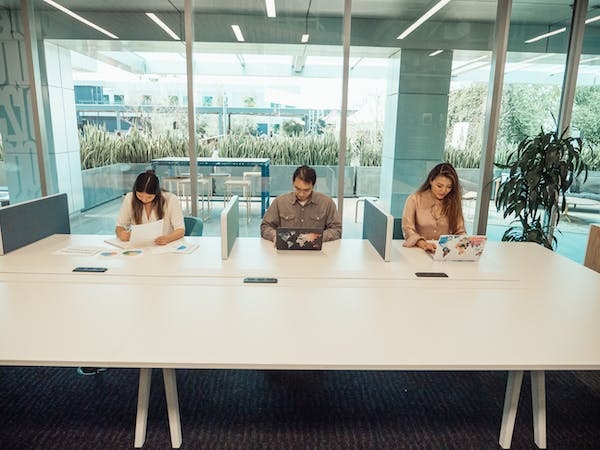The co-working industry has gained immense popularity in recent years, providing a space for freelancers, entrepreneurs, and remote workers to collaborate. As the demand for these shared workspaces grows rapidly, trends within the field are also changing quickly.
Table of Contents
This article will explore some of the most important trends to watch out for related to co-working spaces. Specifically, it will analyze how technological advancements have impacted the way people interact with each other and their workspace environment.
Additionally, this piece will examine how many organizations are beginning to customize their workspaces in order to attract different kinds of users. Finally, it will discuss the emerging trend towards incorporating green features into co-working environments in order to create sustainable workplaces.
1. The Rise Of Remote Working Lead To Co Working
It is not hard to imagine the potential of remote working in this era where technology has become an integral part of daily life. However, there are some who may think that it will never take off due to its numerous issues such as data privacy and job security.
Nevertheless, with innovative solutions being developed to address these matters, the rise of remote working is a notable trend to watch out for in co-working spaces.
The advantages brought about by remote working are undeniable:
- Less commuting time for employees translates into higher productivity
- Fewer office space required leads to cost savings
- Improved work-life balance allows individuals more flexibility when managing their personal engagements.
These factors have contributed towards making companies adopt remote working policies which can be seen from various reports indicating the increasing number of people choosing to work remotely instead of at traditional offices.
Moreover, research conducted on this topic shows that employees who work remotely often display greater job satisfaction compared to those based in physical locations. They have more control over their own schedules and receive better support from employers as well as co-workers since communication is largely done through digital channels like emails and video calls.
Therefore, it is clear that remote working presents many opportunities for businesses across different industries, which makes it a promising development to keep an eye on within co-working spaces.

2. Benefits Of A Co Working Space
As the world of work continues to evolve, it is like a wild horse that can no longer be tamed by traditional methods. It needs something more innovative and agile, such as co-working spaces, to keep up with ever changing demands.
Co-working spaces are quickly gaining popularity for several reasons.
- First, they offer an alternative office setup for businesses that cannot afford expensive leases or prefer not to commit to long term rental contracts.
- They also provide access to shared resources and amenities which helps reduce overhead costs.
- Additionally, they foster collaboration among different teams while providing a sense of community within the workspace environment.
These advantages make co-working spaces ideal for remote workers who need flexible hours or want to save on rent expenses.
Furthermore, freelancers and independent contractors benefit from these workspaces. Since it provides them with all the necessary tools and equipment for their projects without having to pay extra fees for them.
Moreover, co-working spaces San Franciso have strong internet connections which allow employees to collaborate online in real time even if they are located thousands of miles away from each other.
The benefits associated with joining a co-working space has led many companies. Both large and small, to explore this option as part of their business strategy. With its ability to increase productivity while reducing overhead costs, there is little doubt why it has become one of the hottest trends in today’s workplace landscape.
3. Predictions For The Future Of Co Working
As the landscape of work continues to evolve, co working spaces have become increasingly popular in recent years. Co working spaces provide a unique opportunity for entrepreneurs and freelancers to collaborate with like-minded individuals, creating an innovative hub for creative development.
With this surge in popularity comes speculation about what trends may shape the future of co working. Like a lightbulb illuminating the darkness, predictions can be made on how these types of workspaces will continue to adapt to modern times.
One such trend that is likely to remain prominent is convenience. Many people are looking for flexible options when it comes to their workspace; they want something accessible and affordable.
To meet this demand, many existing venues are introducing shorter contracts as well as part-time or virtual memberships which make committing less financially daunting. This shift towards more convenient options has allowed companies access to talent from around the world. While also providing greater flexibility for those seeking short-term projects or events.
Technology is rapidly becoming intertwined with almost every aspect of life and it’s no surprise that co working spaces are expected to follow suit.
As technology advances, so too do its applications within the workplace environment. Whether it’s through artificial intelligence (AI), machine learning (ML) or other forms of automation. All elements that could help streamline processes and create efficient operations within co working environments.
On top of this, improved connectivity between different devices as well as enhanced security measures means workers can feel safe knowing that confidential data won’t be compromised if using digital tools within these offices.
The ever-evolving nature of co-working spaces and workplaces requires businesses to stay ahead of the game by remaining agile and flexible enough to cater for changes in customer needs and preferences.
Furthermore, given their propensity towards collaboration rather than competition, they allow organisations ample scope when it comes innovating new ideas or services which further strengthens their appeal both now and into the future.
4. The Impact Of Technology On Co Working
The impact of technology on co working is hard to ignore. As it has transformed the way we collaborate and communicate. It can be seen as a force that drives innovation in the workplace, enabling businesses to stay competitive.
As new technologies emerge and become more commonplace, they will have an ever increasing influence on how we work.
Technology also provides various tools such as project management software which simplifies complex tasks into manageable processes. Hence, allowing teams to optimise their workflow when using co-working spaces.
Furthermore, by leveraging cloud-based platforms, users are able to instantly share documents without creating multiple versions or wasting time due to slow loading speeds.
All this adds up to increased efficiency within co working industry and spaces. And it is making them more attractive than traditional office environments while keeping costs low.
It’s clear that technology has revolutionised the concept of co working and continues to shape its future development. Its potential benefits are promising. From cost savings through automatisation of mundane tasks all the way up to improved collaboration methods for teams spread around the world.
By staying ahead of technological trends companies can ensure that their workspace remains efficient and effective long into the future.

5. Innovations In Co Working Design
The co-working industry has been rapidly growing in recent years. Because more and more people are opting to work remotely.
One key trend that has emerged is the focus on environmental sustainability when designing new workspaces. With an increasing awareness amongst consumers about climate change and its effects on our planet, eco-friendly designs have become increasingly popular.
In addition to creating aesthetically pleasing green areas with plants and natural materials. Some companies also incorporate energy efficient lighting systems into their workspace designs. And this can help reduce electricity costs significantly.
Another innovation seen recently is the use of collaborative technology. This allows workers from different locations to easily connect with each other and collaborate on projects.
By utilizing tools such as video conferencing software or interactive whiteboards, remote teams can stay connected even if they’re not working face-to-face together. This type of technology also helps create a sense of community amongst coworkers. Coworkers may be spread out across multiple cities or countries. Something that traditional office environments often lack.
Innovations like these demonstrate how thoughtful design choices can enhance the user experience while helping businesses save resources at the same time.
As such, it’s essential for those looking to launch a successful co-working business to keep up with these latest trends so they can ensure their space remains both attractive and cost effective for potential customers.
6. Strategies For Making The Most Of Co-Working
As the world of work continues to rapidly evolve, businesses must find ways to remain competitive and take advantage of co-working environments.
It is important for organizations to understand how best to make use of these spaces in order to maximize productivity. And reduce costs and create a conducive environment for collaboration.
Strategies such as adopting an agile approach, embracing technology and focusing on culture are essential for making the most out of co-working.
An agile approach involves rearranging physical space according to changing needs. This can be possible by creating versatile furniture layouts that allow employees or teams to move around easily.
Additionally, flexibility with respect to job roles is pivotal in adapting quickly in dynamic co-working environments. This helps ensure maximum utilization of resources while enabling responsiveness towards changes in demand.
A company’s success depends on its ability to foster an environment where team members feel supported and respected. To do so, employers should prioritize building relationships between colleagues through activities. These can be group lunches or after-work events held outside the office premises.
Such events can cultivate strong bonds outside the workplace boundaries resulting in increased motivation and improved morale among staff members.
As a result, they will be better equipped not only to handle challenging tasks. But embrace change with greater enthusiasm due to their stronger sense of unity.
Conclusion on Co-Working Spaces and Industry
The co working industry has seen a huge surge in recent years. Because remote workers and entrepreneurs increasingly opting for the flexible arrangements and cost-effective solutions. As we look to the future of co working industry, it’s important that businesses consider the trends and developments taking place in order to remain competitive.
Technology is playing an ever increasing role in how workspaces operate. While innovations such as smart furniture and onsite amenities can offer both comfort and convenience to customers.
Strategic planning will be essential for those looking to make the most of their co working experiences. As well as ensuring that they are up-to-date with current practices. In essence, staying abreast of new technology advancements, along with adapting to customer needs, will be paramount if companies wish to stay ahead of the curve.

Vice President, İntelligent Design & Consultancy Ltd
Over 12 years of global & rich experience in Portfolio & Program Delivery Management in leading & managing IT Governance, PMO, IT Portfolio/Program, IT Products, IT service delivery management, Budget Management, and more.















